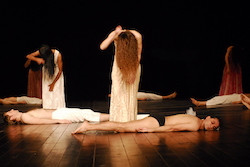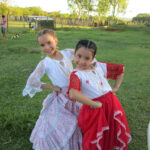Are you asking, “Where Can I Go To Dance?” Look no further. At ten-dance.com, we understand your passion. We are committed to helping you discover vibrant dance studios, classes, and communities, where you can explore various dance forms, refine your skills, and connect with fellow dance enthusiasts. Whether you’re into ballet, hip-hop, salsa, or contemporary, let’s find the perfect spot for you to unleash your inner dancer! Our user-friendly platform connects you with top-rated dance resources, ensuring you find the ideal place to express yourself through movement. Start your dance journey today with ten-dance.com and explore studios, workshops, and personalized dance experiences.
1. Understanding Your Dance Aspirations
Before diving into the myriad of dance options available, it’s essential to understand your personal dance aspirations. What are you hoping to achieve through dance? Is it fitness, artistic expression, social connection, or perhaps a combination of all three? Understanding your goals will significantly influence where you choose to dance.
1.1. Identifying Your Dance Goals
Start by identifying your dance goals. Are you looking to:
- Learn a specific dance style?
- Improve your fitness and flexibility?
- Meet new people and socialize?
- Perform on stage or compete?
- Simply have fun and relieve stress?
1.2. Assessing Your Current Dance Level
Next, assess your current dance level. Are you a complete beginner, or do you have some experience in a particular dance style? Be honest with yourself about your abilities, as this will help you choose classes that are appropriate for your skill level.
1.3. Considering Your Personal Preferences
Finally, consider your personal preferences. What kind of music do you enjoy dancing to? What kind of atmosphere are you looking for in a dance class? Do you prefer a structured learning environment or a more informal setting?
2. Exploring Different Dance Styles
The world of dance is incredibly diverse, with a wide range of styles to choose from. Each style offers its unique blend of movements, music, and cultural influences. Exploring different dance styles can help you discover your true passion.
2.1. Ballet
Ballet is a classical dance form known for its grace, precision, and technical difficulty. It emphasizes posture, alignment, and fluid movements.
- Benefits: Improves posture, flexibility, and coordination.
- Ideal for: Those seeking a disciplined and structured dance form.
2.2. Contemporary
Contemporary dance is a modern genre that incorporates elements of ballet, jazz, and modern dance. It emphasizes self-expression, creativity, and fluidity.
- Benefits: Enhances creativity, emotional expression, and physical strength.
- Ideal for: Dancers who enjoy improvising and exploring movement.
2.3. Hip-Hop
Hip-hop dance is a dynamic and energetic style that originated in the African American community. It includes various styles like breaking, popping, locking, and house.
- Benefits: Improves cardiovascular health, coordination, and rhythm.
- Ideal for: Those who love high-energy music and dynamic movements.
2.4. Jazz
Jazz dance is a lively and expressive style that incorporates elements of ballet, modern, and African dance. It emphasizes rhythm, improvisation, and personal style.
- Benefits: Enhances rhythm, coordination, and personal expression.
- Ideal for: Dancers who enjoy a blend of technique and creativity.
2.5. Salsa
Salsa is a vibrant and sensual Latin dance style known for its fast-paced rhythms and intricate partner work. It is a social dance that emphasizes connection and improvisation.
- Benefits: Improves cardiovascular health, coordination, and social skills.
- Ideal for: Those who enjoy social dancing and Latin music.
2.6. Other Dance Styles
The list of dance styles is endless. Some other popular options include:
- Ballroom: Waltz, Tango, Foxtrot
- Tap: Rhythmic footwork and percussive sounds
- Lyrical: Emotional and expressive movements set to music
- Zumba: Fitness-based dance workout
- Bollywood: Energetic and colorful Indian dance style
3. Finding Dance Classes and Studios
Once you have a good idea of the dance styles you’re interested in, the next step is to find dance classes and studios in your area. Here are some effective strategies:
3.1. Online Search
The internet is a great resource for finding dance classes and studios. Use search engines like Google, Bing, or DuckDuckGo to search for “dance classes near me” or “[your city] dance studios.” Be specific with your search terms to narrow down the results. For example, if you’re interested in ballet, search for “ballet classes in [your city].”
3.2. Online Dance Platforms
Explore online dance platforms like ten-dance.com, which is designed to connect dancers of all levels with studios, instructors, and workshops. These platforms often have reviews and ratings, making it easier to find high-quality classes.
3.3. Social Media
Social media platforms like Facebook, Instagram, and TikTok can be valuable resources for finding dance classes and studios. Many studios have active social media accounts where they post class schedules, workshops, and special events.
3.4. Community Centers and YMCAs
Community centers and YMCAs often offer affordable dance classes for adults and children. Check your local community center’s website or visit in person to see what dance programs they offer.
3.5. University and College Dance Programs
If you live near a university or college with a dance program, consider taking a class there. Many universities offer dance classes to the general public, providing access to high-quality instruction and facilities.
3.6. Word-of-Mouth Referrals
Ask friends, family members, or colleagues if they know of any good dance classes or studios in the area. Word-of-mouth referrals can be a reliable way to find classes that are a good fit for you.
4. Evaluating Dance Studios and Classes
Once you’ve compiled a list of potential dance studios and classes, it’s important to evaluate them carefully to ensure they meet your needs and expectations.
4.1. Instructor Qualifications and Experience
One of the most important factors to consider is the qualifications and experience of the instructor. Look for instructors who have formal training in the dance styles they teach and a proven track record of success.
4.2. Class Size and Structure
Consider the class size and structure. Do you prefer smaller classes with more individualized attention, or larger classes with a more social atmosphere? Is the class structured with a warm-up, technique work, and choreography, or is it more open-ended?
4.3. Studio Facilities and Atmosphere
Visit the studio to assess its facilities and atmosphere. Is the studio clean and well-maintained? Does it have sprung floors to prevent injuries? Is the atmosphere welcoming and supportive?
4.4. Class Schedule and Pricing
Check the class schedule to see if it fits your availability. Consider the pricing structure and whether it aligns with your budget. Many studios offer introductory discounts or package deals.
4.5. Trial Classes
Take advantage of trial classes whenever possible. This is the best way to experience the class firsthand and see if it’s a good fit for you. Pay attention to how the instructor teaches, the energy of the class, and how you feel while dancing.
5. Essential Elements of a Great Dance Class
What makes a dance class truly great? Here are some essential elements to look for:
5.1. Qualified and Passionate Instructors
Great dance classes are led by qualified and passionate instructors who are knowledgeable about their dance style and committed to helping their students succeed. They should be able to provide clear instructions, offer constructive feedback, and create a positive and supportive learning environment. According to research from The Juilliard School, effective dance instruction significantly enhances a student’s technical skills and artistic expression.
5.2. Well-Structured Classes
A well-structured dance class typically includes:
- Warm-up: Prepares the body for movement and prevents injuries.
- Technique Work: Focuses on developing proper form and alignment.
- Choreography: Teaches new steps and combinations.
- Cool-down: Helps the body recover and reduces muscle soreness.
5.3. Positive and Supportive Environment
A positive and supportive environment is essential for learning and growth. The instructor should encourage students to take risks, celebrate their successes, and provide constructive feedback in a kind and respectful manner.
5.4. Clear Communication
Clear communication is key to effective teaching. The instructor should be able to explain concepts clearly, demonstrate movements accurately, and answer students’ questions thoroughly.
5.5. Individualized Attention
While group classes are common, a great dance class provides individualized attention to each student. The instructor should be able to identify areas where students need help and offer personalized guidance and support.
6. Overcoming Common Challenges in Dance
Learning to dance can be challenging, but with the right mindset and strategies, you can overcome these obstacles and achieve your dance goals.
6.1. Dealing with Self-Doubt and Imposter Syndrome
It’s common to experience self-doubt and imposter syndrome, especially when starting something new. Remember that everyone starts somewhere, and progress takes time and effort. Focus on your own journey and celebrate your achievements, no matter how small.
6.2. Managing Performance Anxiety
Performance anxiety can be a major obstacle for dancers who want to perform on stage or compete. Practice performing in front of others to build your confidence. Visualize success and focus on the joy of dancing, rather than the fear of failure.
6.3. Preventing and Managing Injuries
Injuries are a common concern for dancers. To prevent injuries, warm up thoroughly before each class, use proper technique, and listen to your body. If you experience pain, stop dancing and seek medical attention.
6.4. Staying Motivated and Inspired
Staying motivated and inspired can be challenging, especially when progress feels slow. Set realistic goals, find a dance buddy to support you, and attend dance performances to stay inspired.
7. The Benefits of Dancing
Dancing is not only a fun and creative activity, but it also offers numerous physical, mental, and emotional benefits.
7.1. Physical Benefits
Dancing is a great way to improve your physical health. It can:
- Improve cardiovascular health
- Increase strength and endurance
- Enhance flexibility and coordination
- Promote weight loss
- Improve balance and posture
7.2. Mental Benefits
Dancing can also improve your mental well-being. It can:
- Reduce stress and anxiety
- Boost self-esteem
- Improve cognitive function
- Enhance creativity
- Increase body awareness
7.3. Emotional Benefits
Dancing can have a profound impact on your emotional well-being. It can:
- Promote emotional expression
- Increase feelings of joy and happiness
- Foster social connection
- Provide a sense of accomplishment
- Enhance overall quality of life
8. Building a Dance Community
Dancing is more fun when you’re part of a supportive community. Here are some ways to build your dance community:
8.1. Connecting with Fellow Dancers in Class
Make an effort to connect with fellow dancers in your classes. Introduce yourself, ask about their dance experience, and offer encouragement and support.
8.2. Joining Dance Groups and Clubs
Join dance groups and clubs to meet like-minded individuals and participate in dance-related activities.
8.3. Attending Dance Events and Performances
Attend dance events and performances to support local dancers and connect with other dance enthusiasts.
8.4. Participating in Dance Workshops and Intensives
Participate in dance workshops and intensives to learn new skills, meet new people, and immerse yourself in the world of dance.
9. Dance Events and Opportunities in the USA
The United States is a vibrant hub for dance, offering a wide range of events and opportunities for dancers of all levels.
9.1. Dance Festivals and Competitions
Attend dance festivals and competitions to showcase your skills, learn from other dancers, and gain exposure. Some popular dance festivals and competitions in the USA include:
| Event | Location | Description |
|---|---|---|
| Jacob’s Pillow Dance Festival | Becket, MA | One of the oldest and most prestigious dance festivals in the United States, featuring a wide range of dance styles. |
| American Dance Festival | Durham, NC | A renowned festival that showcases modern and contemporary dance. |
| World of Dance Championship | Los Angeles, CA | An international dance competition featuring hip-hop and street dance styles. |
| New York City Dance Week | New York, NY | A week-long celebration of dance with free and discounted classes and performances. |
| USA Dance National DanceSport Championships | Various locations | A national competition for ballroom and Latin dancers. |
9.2. Dance Workshops and Master Classes
Participate in dance workshops and master classes to learn from renowned instructors and improve your skills. Many dance studios and organizations offer workshops and master classes throughout the year.
9.3. Auditions and Performance Opportunities
If you’re interested in performing, look for auditions and performance opportunities with local dance companies, theaters, and community organizations.
9.4. Dance Conventions
Dance conventions offer a unique opportunity to take classes from top instructors, network with other dancers, and learn about the latest trends in the dance industry.
10. Finding Inspiration and Resources for Dance
To continue growing as a dancer, it’s important to seek out inspiration and resources that can help you learn and develop your skills.
10.1. Watching Dance Performances and Videos
Watch dance performances and videos to learn from professional dancers and gain inspiration for your own dancing.
10.2. Reading Dance Books and Articles
Read dance books and articles to deepen your knowledge of dance history, technique, and choreography.
10.3. Following Dance Influencers and Blogs
Follow dance influencers and blogs on social media to stay up-to-date on the latest trends and techniques in the dance world.
10.4. Utilizing Online Dance Tutorials and Platforms
Utilize online dance tutorials and platforms to learn new steps, improve your technique, and explore different dance styles. Ten-dance.com offers a wealth of resources for dancers of all levels, from beginner tutorials to advanced choreography.
 Ballerina Performing
Ballerina Performing
10.5. Taking Advantage of Resources at Ten-Dance.com
At ten-dance.com, we offer a wide range of resources to help you on your dance journey. Explore our:
- Directory of dance studios and classes: Find the perfect studio near you.
- Online dance tutorials: Learn new steps and techniques from expert instructors.
- Articles and blog posts: Discover tips, advice, and inspiration for dancers.
- Community forum: Connect with other dancers and share your experiences.
FAQ: Your Dance Questions Answered
1. What is the best age to start dancing?
There’s no “best” age to start dancing. Some dancers begin as young children, while others start as adults. It’s never too late to pursue your passion for dance.
2. What should I wear to my first dance class?
Wear comfortable clothing that allows you to move freely. For ballet and jazz classes, form-fitting attire like leggings and a leotard is recommended. For hip-hop and other street dance styles, loose-fitting clothing is appropriate.
3. Do I need to have any prior experience to take a dance class?
No prior experience is necessary to take a beginner dance class. Instructors will teach you the basics and help you develop your skills.
4. How often should I take dance classes?
The frequency of your dance classes depends on your goals and availability. Aim for at least one or two classes per week to see progress.
5. What if I’m not flexible enough to dance?
Flexibility is not a prerequisite for dancing. Dance classes can actually help improve your flexibility over time.
6. How can I find a good dance instructor?
Look for instructors who have formal training in the dance styles they teach, a proven track record of success, and a positive and supportive teaching style.
7. What if I feel self-conscious about dancing in front of others?
It’s normal to feel self-conscious when dancing in front of others. Remember that everyone is there to learn and have fun. Focus on your own journey and celebrate your progress.
8. How can I improve my dance technique?
Practice regularly, focus on proper form and alignment, and seek feedback from your instructor.
9. What are some common dance injuries and how can I prevent them?
Common dance injuries include sprains, strains, and tendinitis. Prevent injuries by warming up thoroughly before each class, using proper technique, and listening to your body.
10. Where can I find affordable dance classes?
Community centers, YMCAs, and some universities offer affordable dance classes. Look for introductory discounts or package deals.
Conclusion: Embrace Your Dance Journey
So, where can I go to dance? The answer is: anywhere that ignites your passion and helps you achieve your dance goals! Whether you choose a traditional studio, an online platform, or a community center, the most important thing is to take that first step and start dancing. Remember to define your dance goals, explore various styles, and find classes that fit your needs.
At ten-dance.com, we’re here to support you every step of the way. Our platform is designed to connect you with the best dance resources, from studios and instructors to workshops and events. Join our community of dance enthusiasts and unlock your full potential.
Don’t let anything hold you back from pursuing your love of dance. Embrace the challenges, celebrate the successes, and enjoy the journey. Your dance adventure awaits!
Ready to find the perfect place to dance? Visit ten-dance.com today and explore our directory of dance studios, online tutorials, and community resources. Let us help you discover the joy of dance and connect with a vibrant community of fellow dancers. Contact us at: Address: 60 Lincoln Center Plaza, New York, NY 10023, United States. Phone: +1 (212) 769-7000.


